Victorian Desalination Project - Scope, Objectives, Regulations, Risks
VerifiedAdded on 2023/06/14
|13
|2543
|328
AI Summary
This literature identifies the scopes and objectives of the Victorian Desalination Project, at Australia. The roles and regulations to undertake the project are examined here. The risks emerging from the project are identified in the study along with the development of a critical overview of the project.
Contribute Materials
Your contribution can guide someone’s learning journey. Share your
documents today.
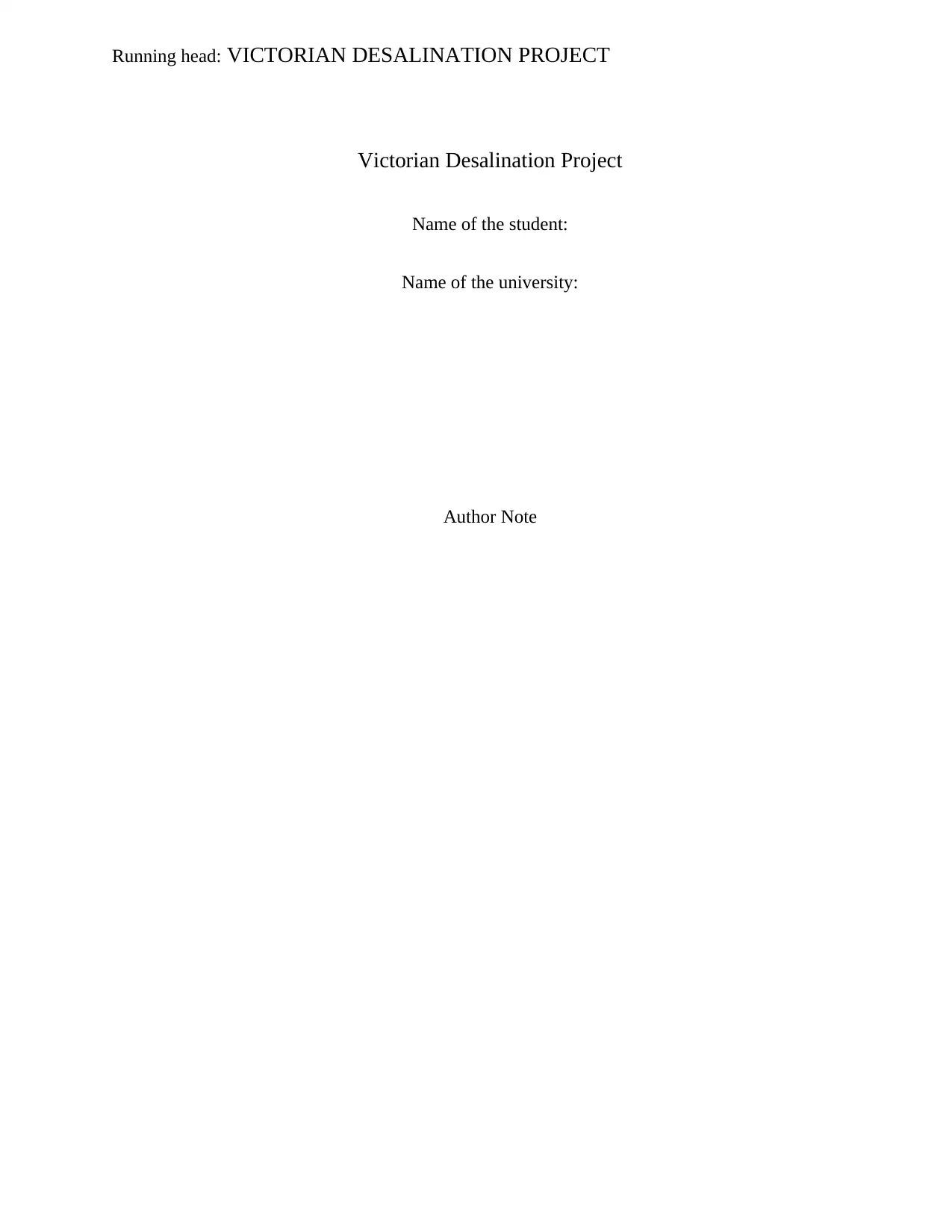
Running head: VICTORIAN DESALINATION PROJECT
Victorian Desalination Project
Name of the student:
Name of the university:
Author Note
Victorian Desalination Project
Name of the student:
Name of the university:
Author Note
Secure Best Marks with AI Grader
Need help grading? Try our AI Grader for instant feedback on your assignments.
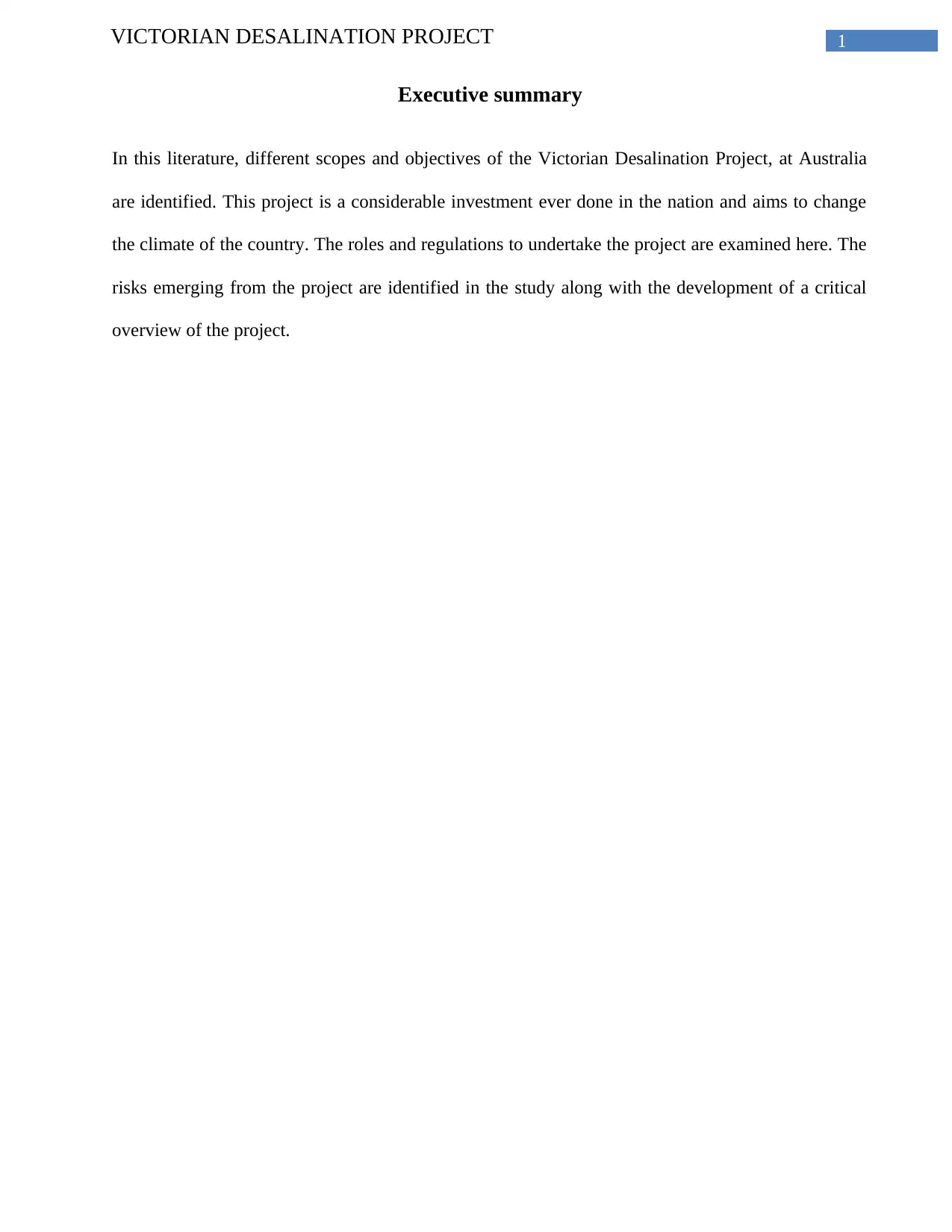
1VICTORIAN DESALINATION PROJECT
Executive summary
In this literature, different scopes and objectives of the Victorian Desalination Project, at Australia
are identified. This project is a considerable investment ever done in the nation and aims to change
the climate of the country. The roles and regulations to undertake the project are examined here. The
risks emerging from the project are identified in the study along with the development of a critical
overview of the project.
Executive summary
In this literature, different scopes and objectives of the Victorian Desalination Project, at Australia
are identified. This project is a considerable investment ever done in the nation and aims to change
the climate of the country. The roles and regulations to undertake the project are examined here. The
risks emerging from the project are identified in the study along with the development of a critical
overview of the project.
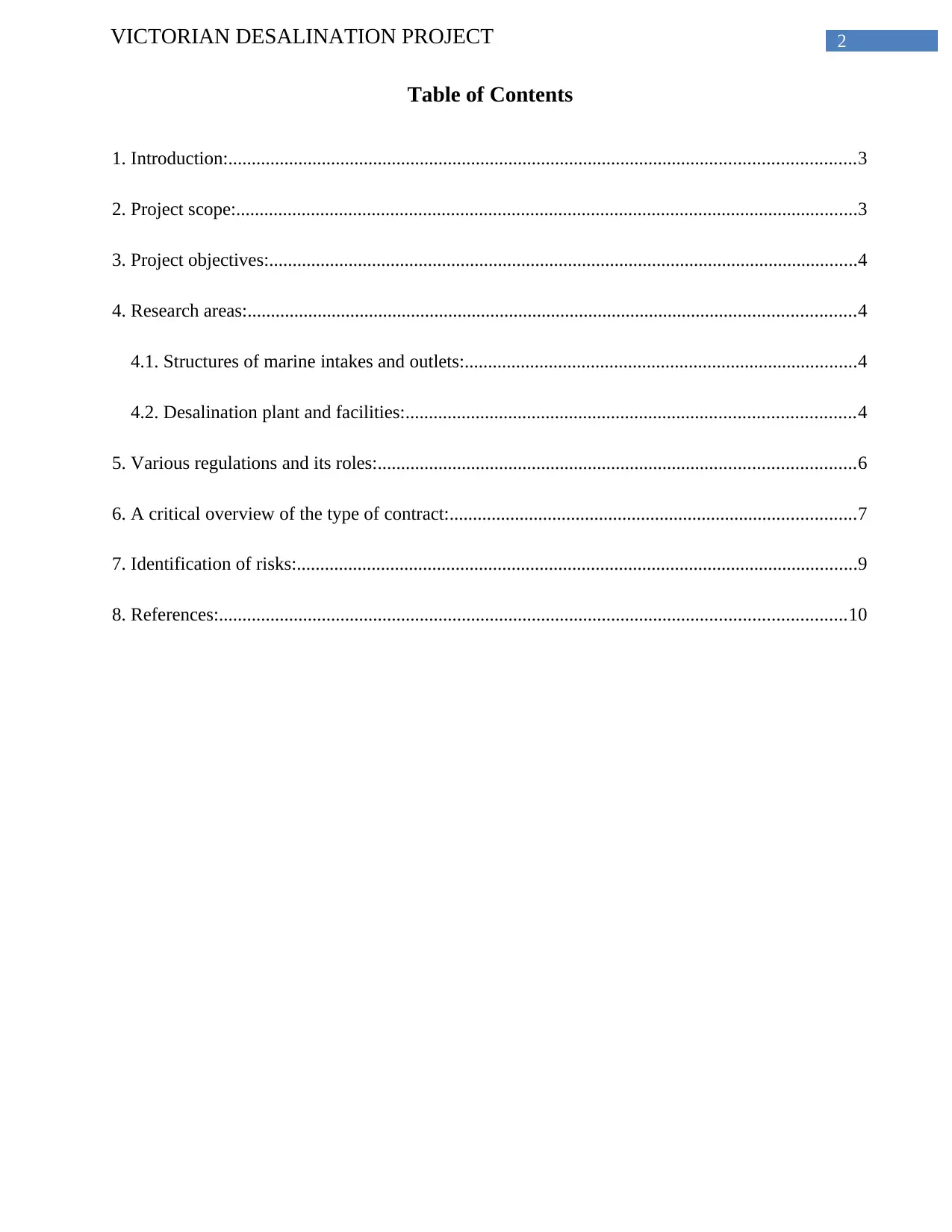
2VICTORIAN DESALINATION PROJECT
Table of Contents
1. Introduction:......................................................................................................................................3
2. Project scope:.....................................................................................................................................3
3. Project objectives:..............................................................................................................................4
4. Research areas:..................................................................................................................................4
4.1. Structures of marine intakes and outlets:....................................................................................4
4.2. Desalination plant and facilities:................................................................................................4
5. Various regulations and its roles:......................................................................................................6
6. A critical overview of the type of contract:.......................................................................................7
7. Identification of risks:........................................................................................................................9
8. References:......................................................................................................................................10
Table of Contents
1. Introduction:......................................................................................................................................3
2. Project scope:.....................................................................................................................................3
3. Project objectives:..............................................................................................................................4
4. Research areas:..................................................................................................................................4
4.1. Structures of marine intakes and outlets:....................................................................................4
4.2. Desalination plant and facilities:................................................................................................4
5. Various regulations and its roles:......................................................................................................6
6. A critical overview of the type of contract:.......................................................................................7
7. Identification of risks:........................................................................................................................9
8. References:......................................................................................................................................10

3VICTORIAN DESALINATION PROJECT
1. Introduction:
The VDP or Victorian Desalination project is a sophisticated infrastructure intended to adopt
climate. It is regarded as one of the top-listed investments done in Australia. Here, Wetlands and
various dune ecologies have been reconnecting different remnants and providing an outstanding
visitor experience (http://fusedigital.com.au, 2018).
In the following study, the various project scopes and objectives are identified. Next,
multiple sectors such as marine intakes, outlet structures, desalination plants are demonstrated here.
Then, different regulations and their roles are assessed. At last a critical review is made on VDP’s
type of contract along with identifying various risks.
2. Project scope:
At 2007, Victoria was under the management of “Millennium Drought: The water storages at
Melbourne were at about 30% and reservoirs feel by 20% for the subsequent months. Further, there
has been a nonstop decrease in storage levels and shortfall taking place between demand and supply
for one year. Due to this problem, suspecting of prolonged droughts for following years and rise in
population, a VDP was needed to be created.
The project intends to create a rainfall independent VDP. This should be able to supply up to
150 GL of quality system of drinking water every year. It also includes delivery of one third of
annual water consumption at Melbourne.
1. Introduction:
The VDP or Victorian Desalination project is a sophisticated infrastructure intended to adopt
climate. It is regarded as one of the top-listed investments done in Australia. Here, Wetlands and
various dune ecologies have been reconnecting different remnants and providing an outstanding
visitor experience (http://fusedigital.com.au, 2018).
In the following study, the various project scopes and objectives are identified. Next,
multiple sectors such as marine intakes, outlet structures, desalination plants are demonstrated here.
Then, different regulations and their roles are assessed. At last a critical review is made on VDP’s
type of contract along with identifying various risks.
2. Project scope:
At 2007, Victoria was under the management of “Millennium Drought: The water storages at
Melbourne were at about 30% and reservoirs feel by 20% for the subsequent months. Further, there
has been a nonstop decrease in storage levels and shortfall taking place between demand and supply
for one year. Due to this problem, suspecting of prolonged droughts for following years and rise in
population, a VDP was needed to be created.
The project intends to create a rainfall independent VDP. This should be able to supply up to
150 GL of quality system of drinking water every year. It also includes delivery of one third of
annual water consumption at Melbourne.
Secure Best Marks with AI Grader
Need help grading? Try our AI Grader for instant feedback on your assignments.

4VICTORIAN DESALINATION PROJECT
3. Project objectives:
The objectives of the project are discussed below:
The design of the plant has aimed to decline numerous adverse effects over local
communities.
Further, the amount of energy required to lift the seawater to the plant is needed to be
reduced.
There has been a necessity of careful designing of tunnels and marine structures for
minimizing the impacts of climate and assure optimal performance for VDP.
4. Research areas:
4.1. Structures of marine intakes and outlets:
In the project water from the desalination plant is transmitted to Melbourne and other
regional sectors through the 84 km underground pipeline. These intakes and outlets have been
connecting the network of Melbourne’s water supply in Berwick. Then it flows into the pipeline
system directly or towards Cardinia Reservoir. Here, the both-way pipeline indicates that water
could be retrieved from Cardinia Reservoir, as the destination plan stops running (Tan‐Kantor,
Abbott and Jubb 2017). The outlets are involved in the pipeline such that various areas at Western
Port and South Gippsland can get access the water from Cardinia Reservoir or plant as needed.
Further, the site for booster pump station has been reflecting community views regarding initial
location proposed that has been exhibited as a vital part of “Environment Effect Statement”.
4.2. Desalination plant and facilities:
It has been situated at Wonthaggi and comprising of the following facilities:
3. Project objectives:
The objectives of the project are discussed below:
The design of the plant has aimed to decline numerous adverse effects over local
communities.
Further, the amount of energy required to lift the seawater to the plant is needed to be
reduced.
There has been a necessity of careful designing of tunnels and marine structures for
minimizing the impacts of climate and assure optimal performance for VDP.
4. Research areas:
4.1. Structures of marine intakes and outlets:
In the project water from the desalination plant is transmitted to Melbourne and other
regional sectors through the 84 km underground pipeline. These intakes and outlets have been
connecting the network of Melbourne’s water supply in Berwick. Then it flows into the pipeline
system directly or towards Cardinia Reservoir. Here, the both-way pipeline indicates that water
could be retrieved from Cardinia Reservoir, as the destination plan stops running (Tan‐Kantor,
Abbott and Jubb 2017). The outlets are involved in the pipeline such that various areas at Western
Port and South Gippsland can get access the water from Cardinia Reservoir or plant as needed.
Further, the site for booster pump station has been reflecting community views regarding initial
location proposed that has been exhibited as a vital part of “Environment Effect Statement”.
4.2. Desalination plant and facilities:
It has been situated at Wonthaggi and comprising of the following facilities:
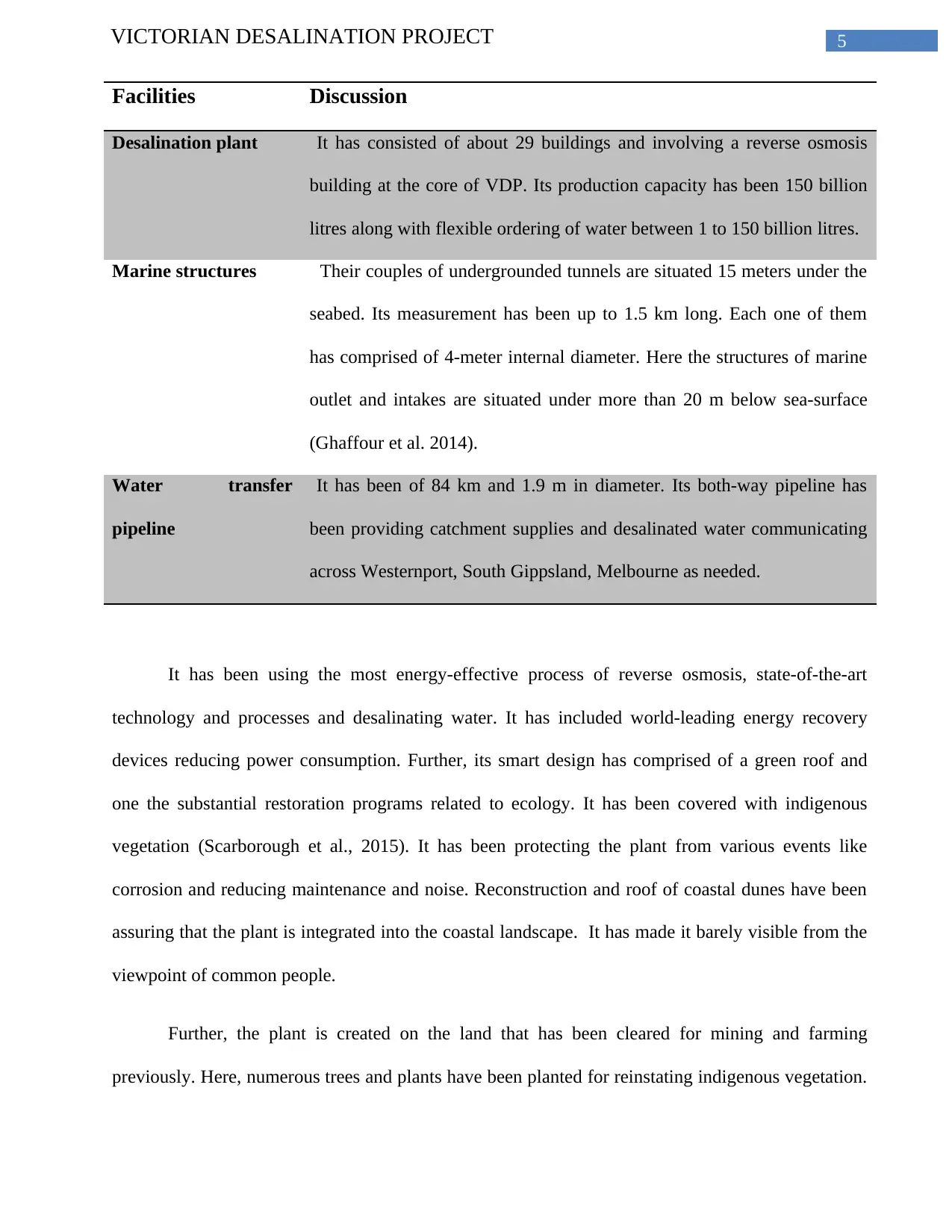
5VICTORIAN DESALINATION PROJECT
Facilities Discussion
Desalination plant It has consisted of about 29 buildings and involving a reverse osmosis
building at the core of VDP. Its production capacity has been 150 billion
litres along with flexible ordering of water between 1 to 150 billion litres.
Marine structures Their couples of undergrounded tunnels are situated 15 meters under the
seabed. Its measurement has been up to 1.5 km long. Each one of them
has comprised of 4-meter internal diameter. Here the structures of marine
outlet and intakes are situated under more than 20 m below sea-surface
(Ghaffour et al. 2014).
Water transfer
pipeline
It has been of 84 km and 1.9 m in diameter. Its both-way pipeline has
been providing catchment supplies and desalinated water communicating
across Westernport, South Gippsland, Melbourne as needed.
It has been using the most energy-effective process of reverse osmosis, state-of-the-art
technology and processes and desalinating water. It has included world-leading energy recovery
devices reducing power consumption. Further, its smart design has comprised of a green roof and
one the substantial restoration programs related to ecology. It has been covered with indigenous
vegetation (Scarborough et al., 2015). It has been protecting the plant from various events like
corrosion and reducing maintenance and noise. Reconstruction and roof of coastal dunes have been
assuring that the plant is integrated into the coastal landscape. It has made it barely visible from the
viewpoint of common people.
Further, the plant is created on the land that has been cleared for mining and farming
previously. Here, numerous trees and plants have been planted for reinstating indigenous vegetation.
Facilities Discussion
Desalination plant It has consisted of about 29 buildings and involving a reverse osmosis
building at the core of VDP. Its production capacity has been 150 billion
litres along with flexible ordering of water between 1 to 150 billion litres.
Marine structures Their couples of undergrounded tunnels are situated 15 meters under the
seabed. Its measurement has been up to 1.5 km long. Each one of them
has comprised of 4-meter internal diameter. Here the structures of marine
outlet and intakes are situated under more than 20 m below sea-surface
(Ghaffour et al. 2014).
Water transfer
pipeline
It has been of 84 km and 1.9 m in diameter. Its both-way pipeline has
been providing catchment supplies and desalinated water communicating
across Westernport, South Gippsland, Melbourne as needed.
It has been using the most energy-effective process of reverse osmosis, state-of-the-art
technology and processes and desalinating water. It has included world-leading energy recovery
devices reducing power consumption. Further, its smart design has comprised of a green roof and
one the substantial restoration programs related to ecology. It has been covered with indigenous
vegetation (Scarborough et al., 2015). It has been protecting the plant from various events like
corrosion and reducing maintenance and noise. Reconstruction and roof of coastal dunes have been
assuring that the plant is integrated into the coastal landscape. It has made it barely visible from the
viewpoint of common people.
Further, the plant is created on the land that has been cleared for mining and farming
previously. Here, numerous trees and plants have been planted for reinstating indigenous vegetation.
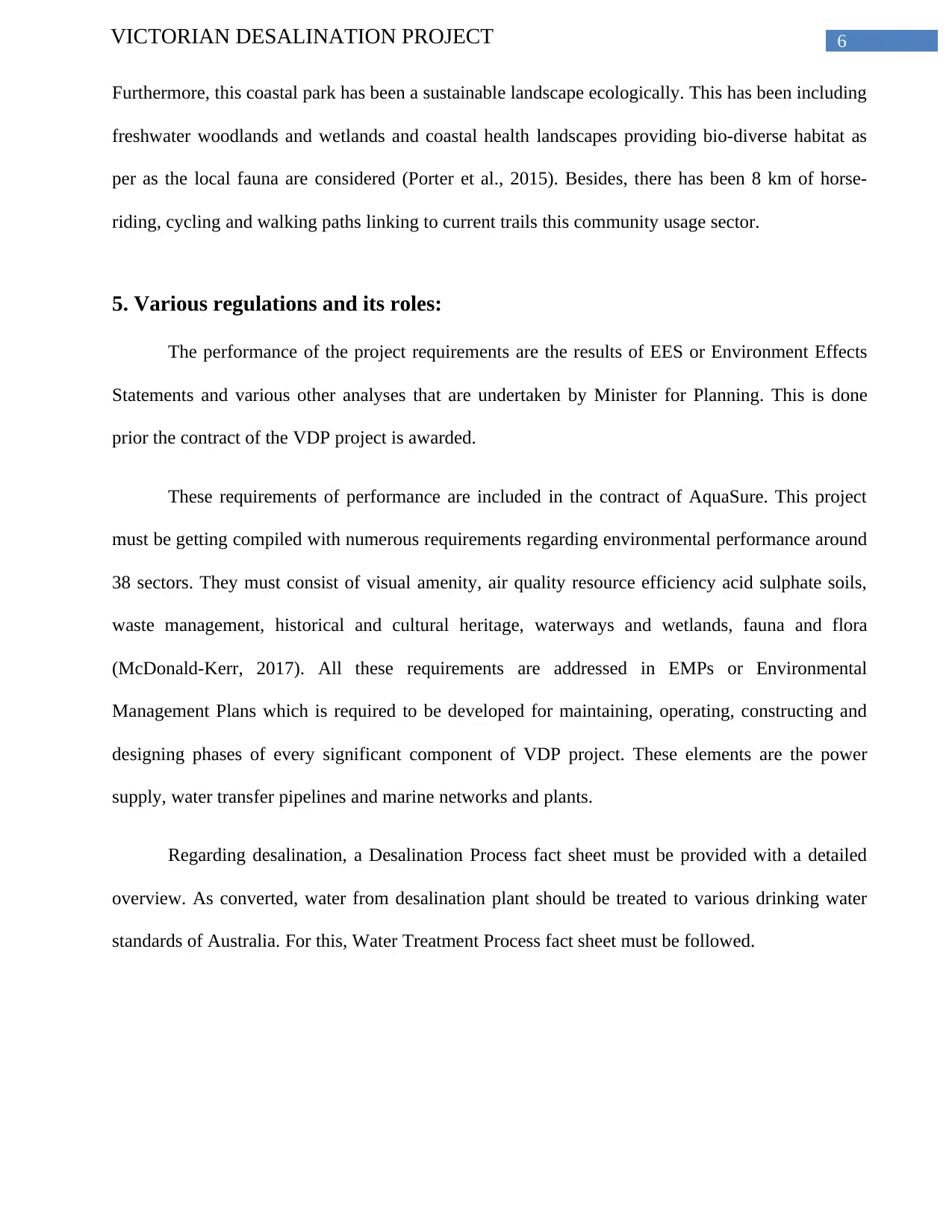
6VICTORIAN DESALINATION PROJECT
Furthermore, this coastal park has been a sustainable landscape ecologically. This has been including
freshwater woodlands and wetlands and coastal health landscapes providing bio-diverse habitat as
per as the local fauna are considered (Porter et al., 2015). Besides, there has been 8 km of horse-
riding, cycling and walking paths linking to current trails this community usage sector.
5. Various regulations and its roles:
The performance of the project requirements are the results of EES or Environment Effects
Statements and various other analyses that are undertaken by Minister for Planning. This is done
prior the contract of the VDP project is awarded.
These requirements of performance are included in the contract of AquaSure. This project
must be getting compiled with numerous requirements regarding environmental performance around
38 sectors. They must consist of visual amenity, air quality resource efficiency acid sulphate soils,
waste management, historical and cultural heritage, waterways and wetlands, fauna and flora
(McDonald-Kerr, 2017). All these requirements are addressed in EMPs or Environmental
Management Plans which is required to be developed for maintaining, operating, constructing and
designing phases of every significant component of VDP project. These elements are the power
supply, water transfer pipelines and marine networks and plants.
Regarding desalination, a Desalination Process fact sheet must be provided with a detailed
overview. As converted, water from desalination plant should be treated to various drinking water
standards of Australia. For this, Water Treatment Process fact sheet must be followed.
Furthermore, this coastal park has been a sustainable landscape ecologically. This has been including
freshwater woodlands and wetlands and coastal health landscapes providing bio-diverse habitat as
per as the local fauna are considered (Porter et al., 2015). Besides, there has been 8 km of horse-
riding, cycling and walking paths linking to current trails this community usage sector.
5. Various regulations and its roles:
The performance of the project requirements are the results of EES or Environment Effects
Statements and various other analyses that are undertaken by Minister for Planning. This is done
prior the contract of the VDP project is awarded.
These requirements of performance are included in the contract of AquaSure. This project
must be getting compiled with numerous requirements regarding environmental performance around
38 sectors. They must consist of visual amenity, air quality resource efficiency acid sulphate soils,
waste management, historical and cultural heritage, waterways and wetlands, fauna and flora
(McDonald-Kerr, 2017). All these requirements are addressed in EMPs or Environmental
Management Plans which is required to be developed for maintaining, operating, constructing and
designing phases of every significant component of VDP project. These elements are the power
supply, water transfer pipelines and marine networks and plants.
Regarding desalination, a Desalination Process fact sheet must be provided with a detailed
overview. As converted, water from desalination plant should be treated to various drinking water
standards of Australia. For this, Water Treatment Process fact sheet must be followed.
Paraphrase This Document
Need a fresh take? Get an instant paraphrase of this document with our AI Paraphraser
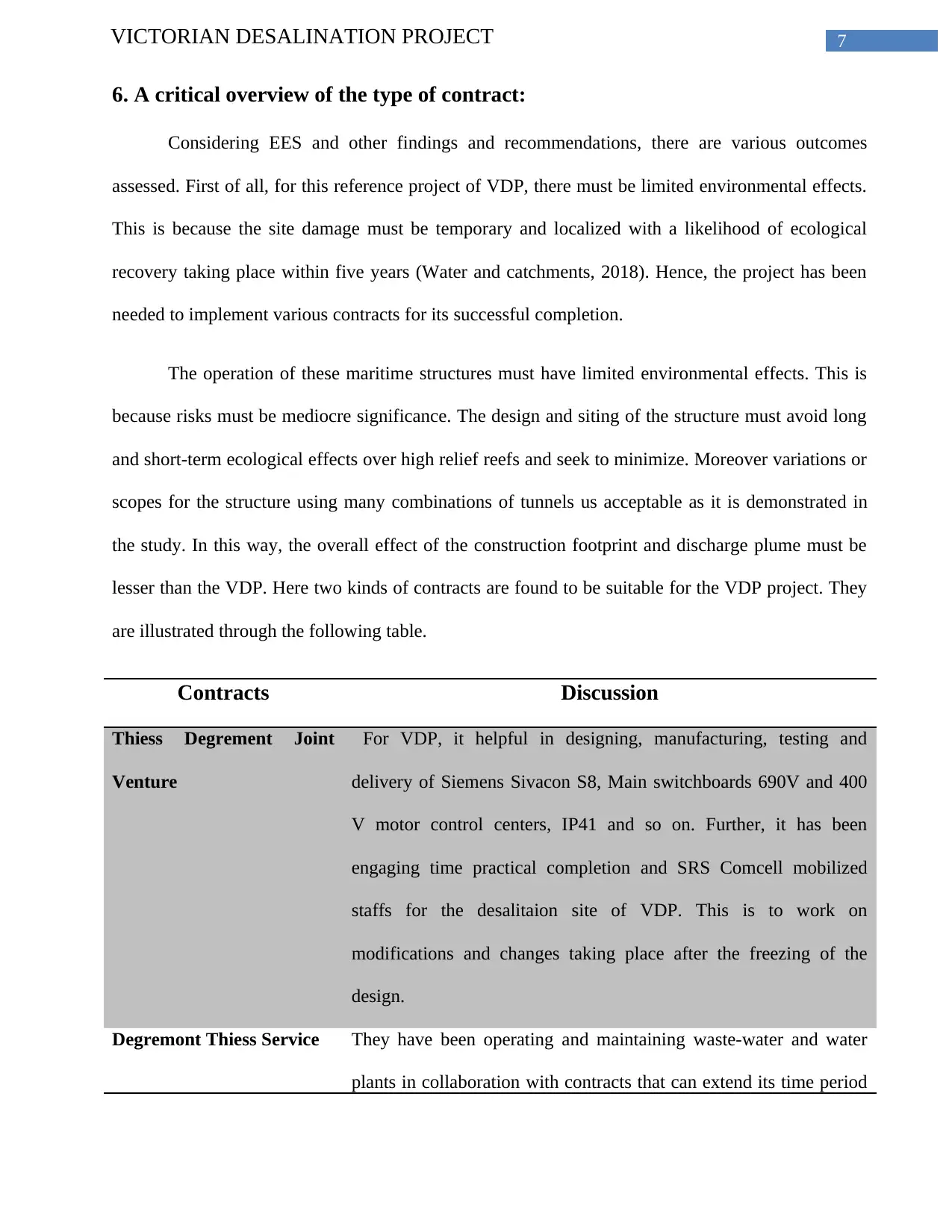
7VICTORIAN DESALINATION PROJECT
6. A critical overview of the type of contract:
Considering EES and other findings and recommendations, there are various outcomes
assessed. First of all, for this reference project of VDP, there must be limited environmental effects.
This is because the site damage must be temporary and localized with a likelihood of ecological
recovery taking place within five years (Water and catchments, 2018). Hence, the project has been
needed to implement various contracts for its successful completion.
The operation of these maritime structures must have limited environmental effects. This is
because risks must be mediocre significance. The design and siting of the structure must avoid long
and short-term ecological effects over high relief reefs and seek to minimize. Moreover variations or
scopes for the structure using many combinations of tunnels us acceptable as it is demonstrated in
the study. In this way, the overall effect of the construction footprint and discharge plume must be
lesser than the VDP. Here two kinds of contracts are found to be suitable for the VDP project. They
are illustrated through the following table.
Contracts Discussion
Thiess Degrement Joint
Venture
For VDP, it helpful in designing, manufacturing, testing and
delivery of Siemens Sivacon S8, Main switchboards 690V and 400
V motor control centers, IP41 and so on. Further, it has been
engaging time practical completion and SRS Comcell mobilized
staffs for the desalitaion site of VDP. This is to work on
modifications and changes taking place after the freezing of the
design.
Degremont Thiess Service They have been operating and maintaining waste-water and water
plants in collaboration with contracts that can extend its time period
6. A critical overview of the type of contract:
Considering EES and other findings and recommendations, there are various outcomes
assessed. First of all, for this reference project of VDP, there must be limited environmental effects.
This is because the site damage must be temporary and localized with a likelihood of ecological
recovery taking place within five years (Water and catchments, 2018). Hence, the project has been
needed to implement various contracts for its successful completion.
The operation of these maritime structures must have limited environmental effects. This is
because risks must be mediocre significance. The design and siting of the structure must avoid long
and short-term ecological effects over high relief reefs and seek to minimize. Moreover variations or
scopes for the structure using many combinations of tunnels us acceptable as it is demonstrated in
the study. In this way, the overall effect of the construction footprint and discharge plume must be
lesser than the VDP. Here two kinds of contracts are found to be suitable for the VDP project. They
are illustrated through the following table.
Contracts Discussion
Thiess Degrement Joint
Venture
For VDP, it helpful in designing, manufacturing, testing and
delivery of Siemens Sivacon S8, Main switchboards 690V and 400
V motor control centers, IP41 and so on. Further, it has been
engaging time practical completion and SRS Comcell mobilized
staffs for the desalitaion site of VDP. This is to work on
modifications and changes taking place after the freezing of the
design.
Degremont Thiess Service They have been operating and maintaining waste-water and water
plants in collaboration with contracts that can extend its time period
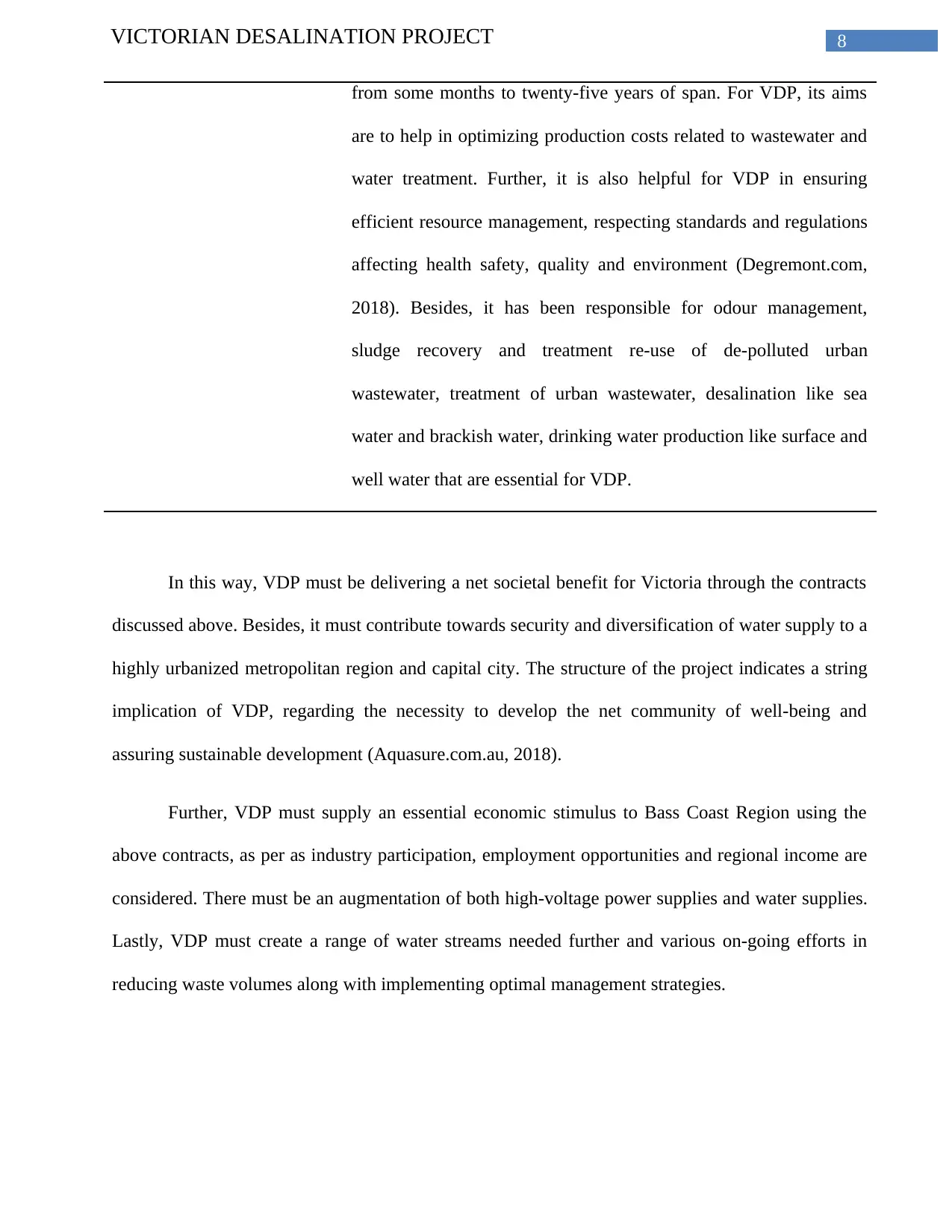
8VICTORIAN DESALINATION PROJECT
from some months to twenty-five years of span. For VDP, its aims
are to help in optimizing production costs related to wastewater and
water treatment. Further, it is also helpful for VDP in ensuring
efficient resource management, respecting standards and regulations
affecting health safety, quality and environment (Degremont.com,
2018). Besides, it has been responsible for odour management,
sludge recovery and treatment re-use of de-polluted urban
wastewater, treatment of urban wastewater, desalination like sea
water and brackish water, drinking water production like surface and
well water that are essential for VDP.
In this way, VDP must be delivering a net societal benefit for Victoria through the contracts
discussed above. Besides, it must contribute towards security and diversification of water supply to a
highly urbanized metropolitan region and capital city. The structure of the project indicates a string
implication of VDP, regarding the necessity to develop the net community of well-being and
assuring sustainable development (Aquasure.com.au, 2018).
Further, VDP must supply an essential economic stimulus to Bass Coast Region using the
above contracts, as per as industry participation, employment opportunities and regional income are
considered. There must be an augmentation of both high-voltage power supplies and water supplies.
Lastly, VDP must create a range of water streams needed further and various on-going efforts in
reducing waste volumes along with implementing optimal management strategies.
from some months to twenty-five years of span. For VDP, its aims
are to help in optimizing production costs related to wastewater and
water treatment. Further, it is also helpful for VDP in ensuring
efficient resource management, respecting standards and regulations
affecting health safety, quality and environment (Degremont.com,
2018). Besides, it has been responsible for odour management,
sludge recovery and treatment re-use of de-polluted urban
wastewater, treatment of urban wastewater, desalination like sea
water and brackish water, drinking water production like surface and
well water that are essential for VDP.
In this way, VDP must be delivering a net societal benefit for Victoria through the contracts
discussed above. Besides, it must contribute towards security and diversification of water supply to a
highly urbanized metropolitan region and capital city. The structure of the project indicates a string
implication of VDP, regarding the necessity to develop the net community of well-being and
assuring sustainable development (Aquasure.com.au, 2018).
Further, VDP must supply an essential economic stimulus to Bass Coast Region using the
above contracts, as per as industry participation, employment opportunities and regional income are
considered. There must be an augmentation of both high-voltage power supplies and water supplies.
Lastly, VDP must create a range of water streams needed further and various on-going efforts in
reducing waste volumes along with implementing optimal management strategies.
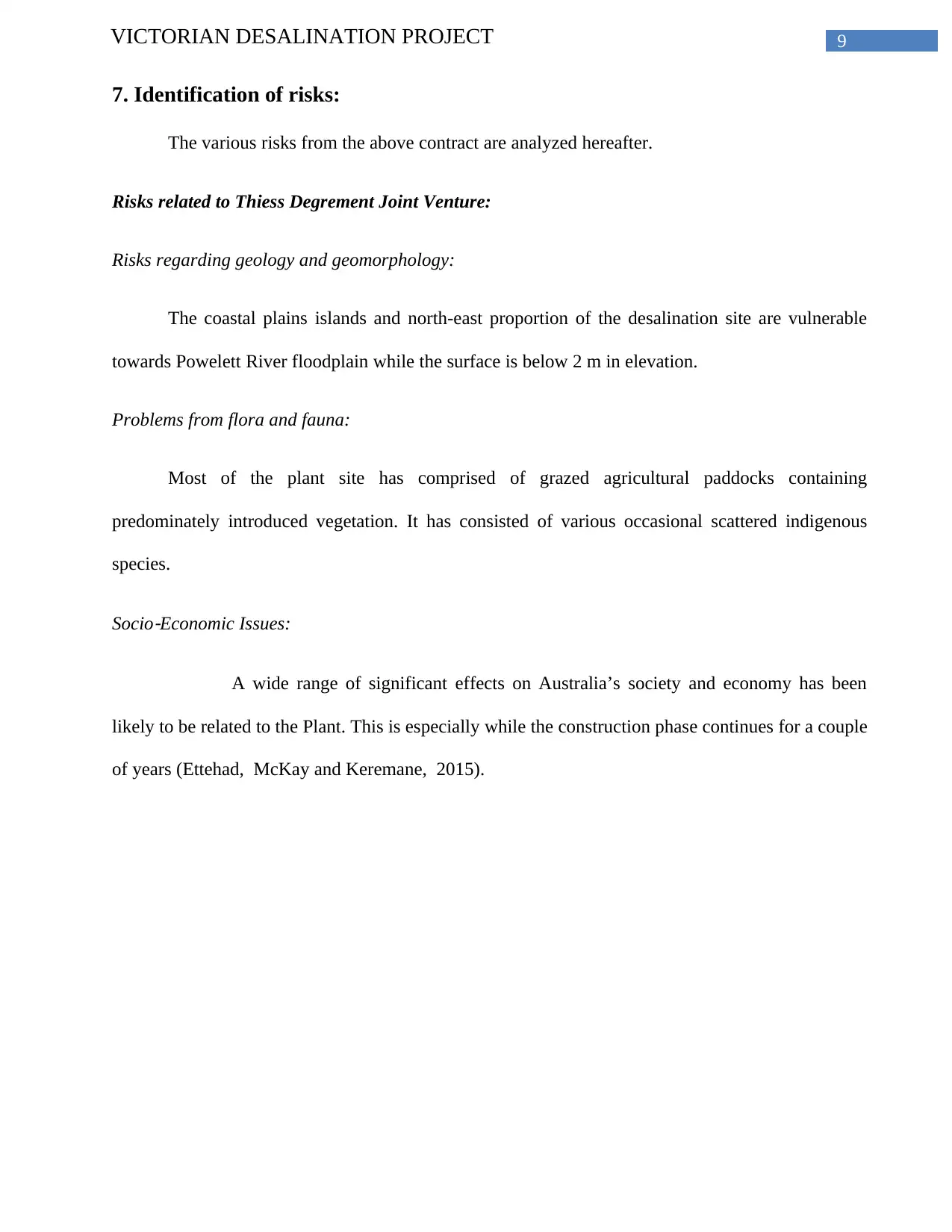
9VICTORIAN DESALINATION PROJECT
7. Identification of risks:
The various risks from the above contract are analyzed hereafter.
Risks related to Thiess Degrement Joint Venture:
Risks regarding geology and geomorphology:
The coastal plains islands and north-east proportion of the desalination site are vulnerable
towards Powelett River floodplain while the surface is below 2 m in elevation.
Problems from flora and fauna:
Most of the plant site has comprised of grazed agricultural paddocks containing
predominately introduced vegetation. It has consisted of various occasional scattered indigenous
species.
Socio
‐Economic Issues:
A wide range of significant effects on Australia’s society and economy has been
likely to be related to the Plant. This is especially while the construction phase continues for a couple
of years (Ettehad, McKay and Keremane, 2015).
7. Identification of risks:
The various risks from the above contract are analyzed hereafter.
Risks related to Thiess Degrement Joint Venture:
Risks regarding geology and geomorphology:
The coastal plains islands and north-east proportion of the desalination site are vulnerable
towards Powelett River floodplain while the surface is below 2 m in elevation.
Problems from flora and fauna:
Most of the plant site has comprised of grazed agricultural paddocks containing
predominately introduced vegetation. It has consisted of various occasional scattered indigenous
species.
Socio
‐Economic Issues:
A wide range of significant effects on Australia’s society and economy has been
likely to be related to the Plant. This is especially while the construction phase continues for a couple
of years (Ettehad, McKay and Keremane, 2015).
Secure Best Marks with AI Grader
Need help grading? Try our AI Grader for instant feedback on your assignments.
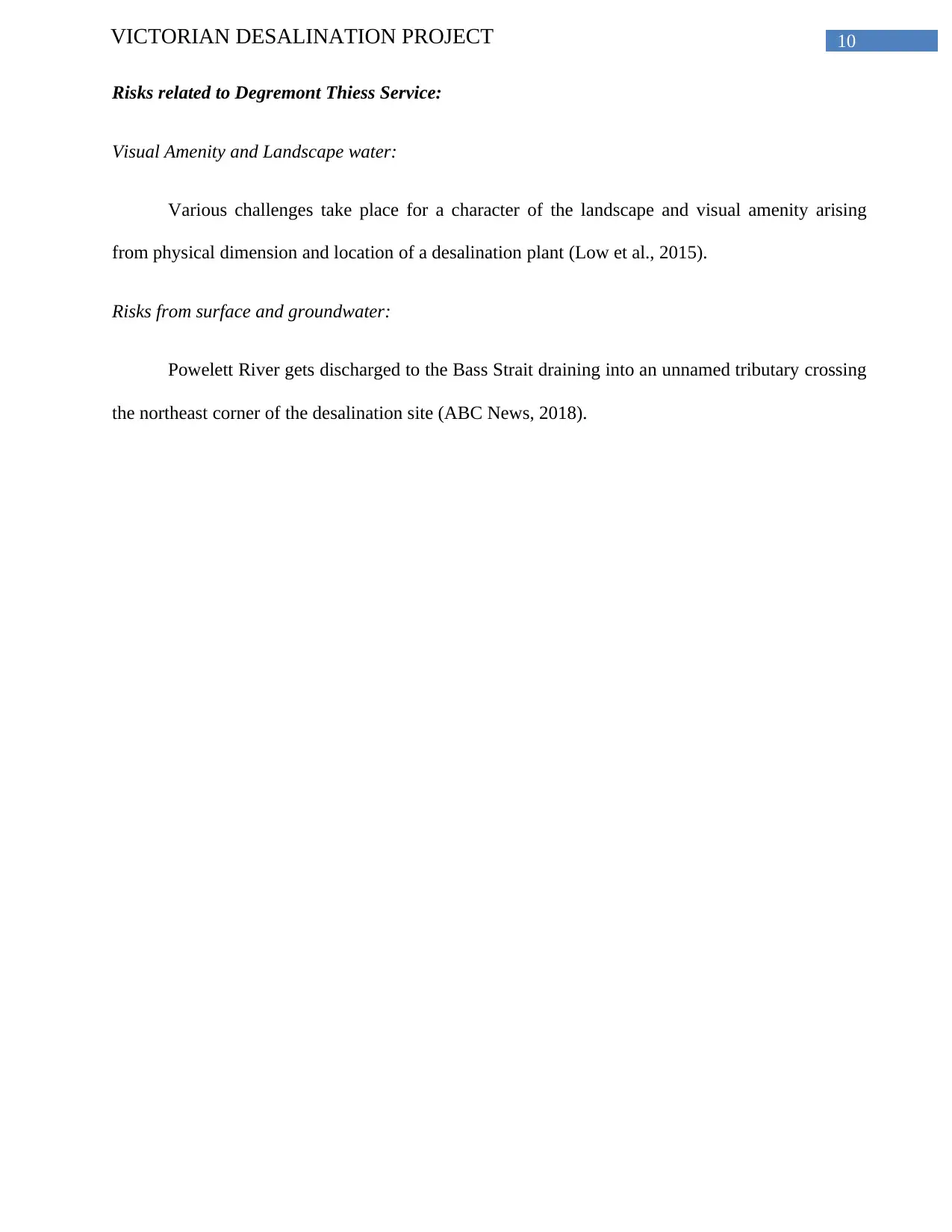
10VICTORIAN DESALINATION PROJECT
Risks related to Degremont Thiess Service:
Visual Amenity and Landscape water:
Various challenges take place for a character of the landscape and visual amenity arising
from physical dimension and location of a desalination plant (Low et al., 2015).
Risks from surface and groundwater:
Powelett River gets discharged to the Bass Strait draining into an unnamed tributary crossing
the northeast corner of the desalination site (ABC News, 2018).
Risks related to Degremont Thiess Service:
Visual Amenity and Landscape water:
Various challenges take place for a character of the landscape and visual amenity arising
from physical dimension and location of a desalination plant (Low et al., 2015).
Risks from surface and groundwater:
Powelett River gets discharged to the Bass Strait draining into an unnamed tributary crossing
the northeast corner of the desalination site (ABC News, 2018).
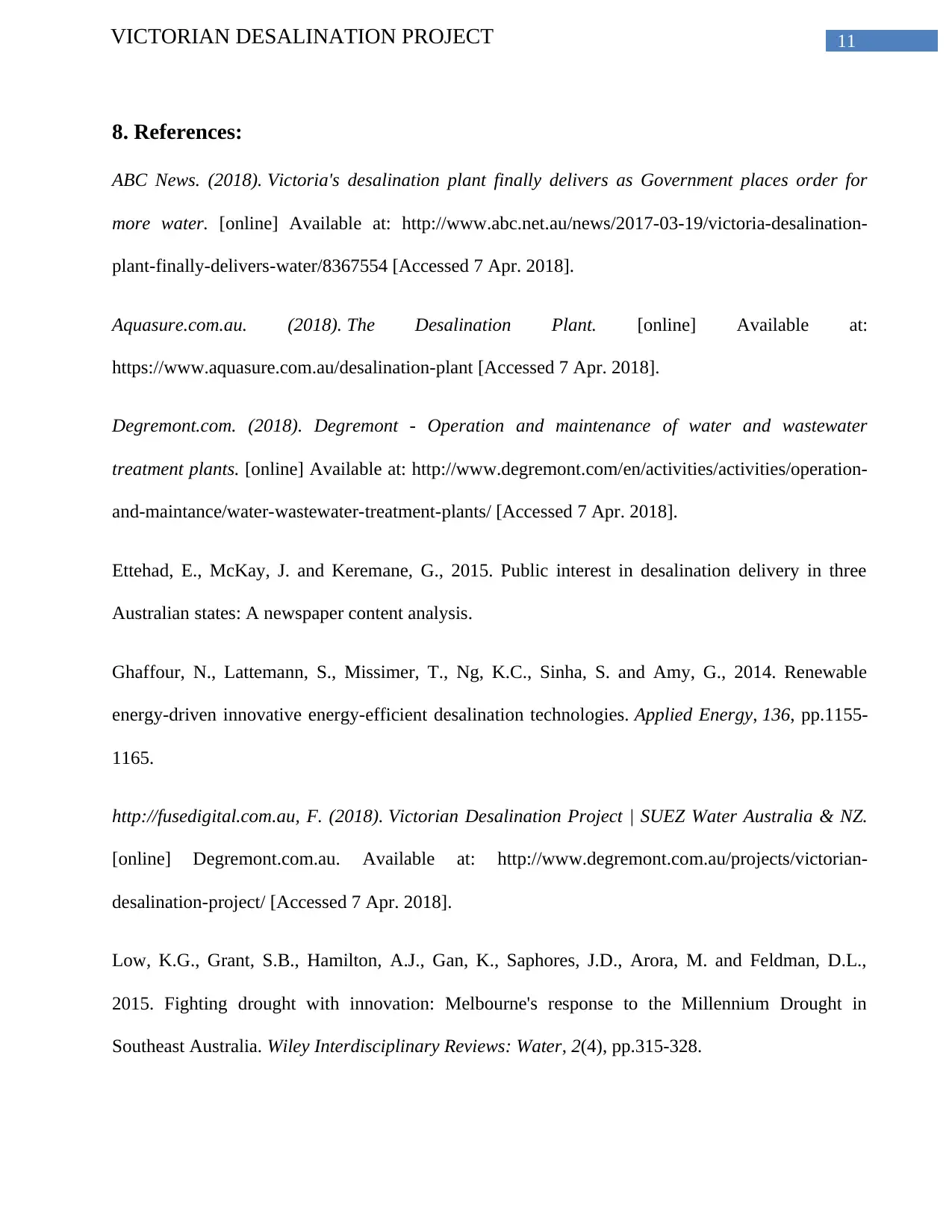
11VICTORIAN DESALINATION PROJECT
8. References:
ABC News. (2018). Victoria's desalination plant finally delivers as Government places order for
more water. [online] Available at: http://www.abc.net.au/news/2017-03-19/victoria-desalination-
plant-finally-delivers-water/8367554 [Accessed 7 Apr. 2018].
Aquasure.com.au. (2018). The Desalination Plant. [online] Available at:
https://www.aquasure.com.au/desalination-plant [Accessed 7 Apr. 2018].
Degremont.com. (2018). Degremont - Operation and maintenance of water and wastewater
treatment plants. [online] Available at: http://www.degremont.com/en/activities/activities/operation-
and-maintance/water-wastewater-treatment-plants/ [Accessed 7 Apr. 2018].
Ettehad, E., McKay, J. and Keremane, G., 2015. Public interest in desalination delivery in three
Australian states: A newspaper content analysis.
Ghaffour, N., Lattemann, S., Missimer, T., Ng, K.C., Sinha, S. and Amy, G., 2014. Renewable
energy-driven innovative energy-efficient desalination technologies. Applied Energy, 136, pp.1155-
1165.
http://fusedigital.com.au, F. (2018). Victorian Desalination Project | SUEZ Water Australia & NZ.
[online] Degremont.com.au. Available at: http://www.degremont.com.au/projects/victorian-
desalination-project/ [Accessed 7 Apr. 2018].
Low, K.G., Grant, S.B., Hamilton, A.J., Gan, K., Saphores, J.D., Arora, M. and Feldman, D.L.,
2015. Fighting drought with innovation: Melbourne's response to the Millennium Drought in
Southeast Australia. Wiley Interdisciplinary Reviews: Water, 2(4), pp.315-328.
8. References:
ABC News. (2018). Victoria's desalination plant finally delivers as Government places order for
more water. [online] Available at: http://www.abc.net.au/news/2017-03-19/victoria-desalination-
plant-finally-delivers-water/8367554 [Accessed 7 Apr. 2018].
Aquasure.com.au. (2018). The Desalination Plant. [online] Available at:
https://www.aquasure.com.au/desalination-plant [Accessed 7 Apr. 2018].
Degremont.com. (2018). Degremont - Operation and maintenance of water and wastewater
treatment plants. [online] Available at: http://www.degremont.com/en/activities/activities/operation-
and-maintance/water-wastewater-treatment-plants/ [Accessed 7 Apr. 2018].
Ettehad, E., McKay, J. and Keremane, G., 2015. Public interest in desalination delivery in three
Australian states: A newspaper content analysis.
Ghaffour, N., Lattemann, S., Missimer, T., Ng, K.C., Sinha, S. and Amy, G., 2014. Renewable
energy-driven innovative energy-efficient desalination technologies. Applied Energy, 136, pp.1155-
1165.
http://fusedigital.com.au, F. (2018). Victorian Desalination Project | SUEZ Water Australia & NZ.
[online] Degremont.com.au. Available at: http://www.degremont.com.au/projects/victorian-
desalination-project/ [Accessed 7 Apr. 2018].
Low, K.G., Grant, S.B., Hamilton, A.J., Gan, K., Saphores, J.D., Arora, M. and Feldman, D.L.,
2015. Fighting drought with innovation: Melbourne's response to the Millennium Drought in
Southeast Australia. Wiley Interdisciplinary Reviews: Water, 2(4), pp.315-328.
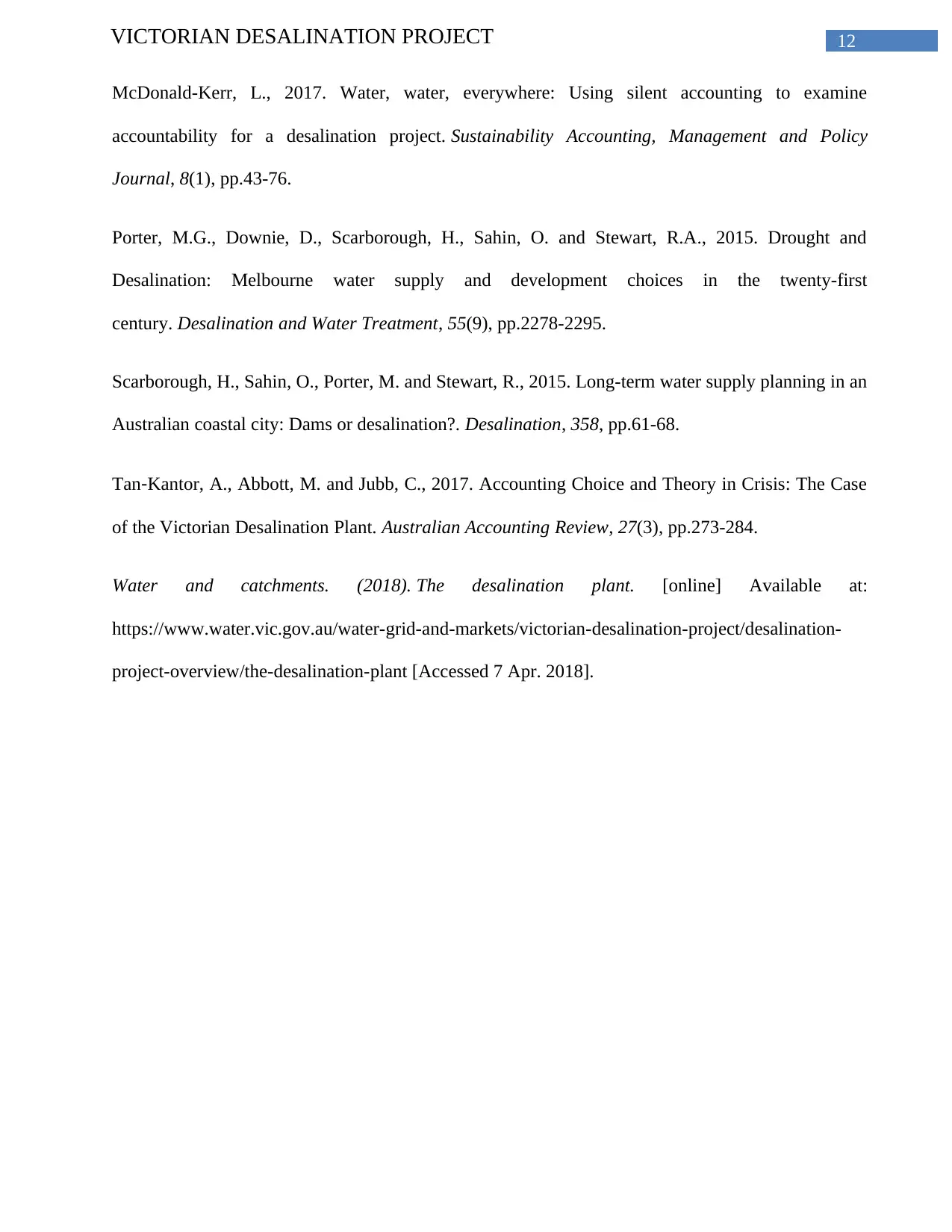
12VICTORIAN DESALINATION PROJECT
McDonald-Kerr, L., 2017. Water, water, everywhere: Using silent accounting to examine
accountability for a desalination project. Sustainability Accounting, Management and Policy
Journal, 8(1), pp.43-76.
Porter, M.G., Downie, D., Scarborough, H., Sahin, O. and Stewart, R.A., 2015. Drought and
Desalination: Melbourne water supply and development choices in the twenty-first
century. Desalination and Water Treatment, 55(9), pp.2278-2295.
Scarborough, H., Sahin, O., Porter, M. and Stewart, R., 2015. Long-term water supply planning in an
Australian coastal city: Dams or desalination?. Desalination, 358, pp.61-68.
Tan‐Kantor, A., Abbott, M. and Jubb, C., 2017. Accounting Choice and Theory in Crisis: The Case
of the Victorian Desalination Plant. Australian Accounting Review, 27(3), pp.273-284.
Water and catchments. (2018). The desalination plant. [online] Available at:
https://www.water.vic.gov.au/water-grid-and-markets/victorian-desalination-project/desalination-
project-overview/the-desalination-plant [Accessed 7 Apr. 2018].
McDonald-Kerr, L., 2017. Water, water, everywhere: Using silent accounting to examine
accountability for a desalination project. Sustainability Accounting, Management and Policy
Journal, 8(1), pp.43-76.
Porter, M.G., Downie, D., Scarborough, H., Sahin, O. and Stewart, R.A., 2015. Drought and
Desalination: Melbourne water supply and development choices in the twenty-first
century. Desalination and Water Treatment, 55(9), pp.2278-2295.
Scarborough, H., Sahin, O., Porter, M. and Stewart, R., 2015. Long-term water supply planning in an
Australian coastal city: Dams or desalination?. Desalination, 358, pp.61-68.
Tan‐Kantor, A., Abbott, M. and Jubb, C., 2017. Accounting Choice and Theory in Crisis: The Case
of the Victorian Desalination Plant. Australian Accounting Review, 27(3), pp.273-284.
Water and catchments. (2018). The desalination plant. [online] Available at:
https://www.water.vic.gov.au/water-grid-and-markets/victorian-desalination-project/desalination-
project-overview/the-desalination-plant [Accessed 7 Apr. 2018].
1 out of 13
Related Documents
Your All-in-One AI-Powered Toolkit for Academic Success.
+13062052269
info@desklib.com
Available 24*7 on WhatsApp / Email
![[object Object]](/_next/static/media/star-bottom.7253800d.svg)
Unlock your academic potential
© 2024 | Zucol Services PVT LTD | All rights reserved.




